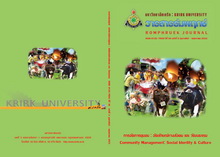วัดมอญจังหวัดราชบุรี : การจัดภูมิทัศน์ และความหมายของอัตลักษณ์ชุมชน
Main Article Content
Abstract
Mon Temples in Ratchaburi Province : Landscape Designs and Definitions of Community Identity
This article aims to describe Mon people in Ratchaburi Province. Who migrated to Thailand and settled down on both sides of Maeklong River, Photharam District and Bangphong District of Ratchaburi Province. When the Mon people expanded their communities, temples were constructed to symbolize the heart and spiritual symbol of the community. There are numerous temples which collect Mon’s historical and cultural knowledge. These temples are; such as Khongkharam Temple of Photharam District and Muang Temple of Bangphong District. The temple can be functionally divided into 2 main parts; the concrete and the abstract. The concrete ones are also devided into two sections : the living quarter and the buildings where religious ceremonies are performed. The abstract one refers the performance according to the beliefs, tradition, ritual and way of life of the Mon people. Both concrete and abstract categorized describe the important identity of Mon; the way of life which they believe in Buddhism, the spirit, the way they dress, food they eat, the “hamsa” mythical swan and Mon styled-pagodas, etc. Mon temples are the area where Mon community identity can be witnessed and propagated. Moreover; the temples are also the place where value of community identity in favor of descendants’ pride as a knowledge source is maintained and to be carried on.
Article Details
Every article published in the Romphruek Journal of the Humanities and Social Sciences is the opinion and point of view of the authors. Thery're not the viewpoint of Krirk University or the editored department. Any part or all of the articles for pablication must be clearly cited.

